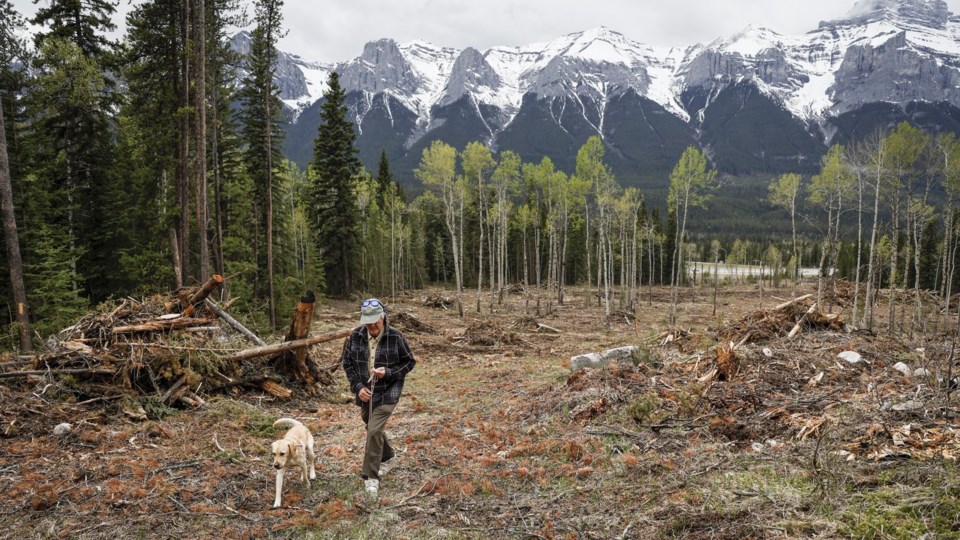BANFF — Looking out over a budding meadow with blackened tree stumps on the edge of Banff National Park, Cliff White points to a dark thicket of trees where the empty plot ends.
"The next fire in here is going to be incredible," says the former Parks Canada fire management co-ordinator, standing in the expansive Carrot Creek fire break.
The meadow was shorn more than 20 years ago by Parks Canada to slow future wildfires in their tracks before reaching Banff and Canmore.
But it's a fraction of the dense, naturally fire-prone forest blanketing the Bow Valley, where fear is growing that a shower of embers, like those that destroyed a third of the structures in Jasper, Alta., last summer, could hit Alberta's most popular tourist destination.
The Rockies are facing another year of drought conditions. The snow melted several weeks earlier than normal, and the snowpack is lower than it was in 2023, the year of Canada’s record-breaking wildfires, said John Pomeroy, a hydrologist who lives in Canmore.
“Canmore’s watching with great trepidation,” said Pomeroy, also a university professor.
In the race to mitigate the damage from future fires, stewards of Alberta's parks have turned to loggers to create fire guards like Carrot Creek. The areas are designed to starve a fire of fuel and create enough empty land for embers to fizzle out on the ground.
This year, Parks Canada hired an Indigenous logging company to raze several hectares of land near Banff. Profits of that timber will be used to maintain the land, said Jane Park, fire and vegetation specialist for Banff National Park.
Each fire break represents the start of a new ecosystem that Parks Canada will need to maintain.
"We can't just let nature do its thing and just have wildfires kind of go willy-nilly," said Park, standing among large slash piles in one of Banff's newest fire breaks.
Though hotter and drier summers have triggered the most damaging wildfire seasons in recent years, decades of fire suppression, starting in the early 1900s, have made forests throughout the Rockies thick tinderboxes.
Fire is part of the natural life cycle for many of those trees, which carry seeds inside their pine cones that are only released when they're on fire, Park said.
Prescribed burning, a traditional Indigenous practice, was stopped more than 100 years ago but restarted in the 1980s when Parks Canada discovered it had allowed the forest to grow out of control, Park said.
"We're still getting back to where we should have been."
The battle against a large wildfire will also be fought inside the mountain towns.
In Canmore, Simon Bagshaw decided to stop taking consulting contracts so he could focus on mitigating the risk a fire could have on his neighbourhood. He has led several events this year, encouraging people to place log piles far away from their homes and to clean their gutters.
It's been a challenge getting the community on board, he said, because many homeowners don't live there full time.
"There's a few of us wearing helmets and the rest are wearing tuques, and we've got to change that."
In Banff, it's already been a topsy-turvy summer for its small fire department. Fire Chief Keri Martens said the dry and hot start to May was nerve-racking, but recent rainy conditions gave her room to breathe.
"The anxiety level certainly starts to rise," Martens said of the early summer season.
Tables inside Banff's fire department are covered in large maps, one of them with the roughly 300 homes with roofs made of combustible materials like cedar shake, which would be most at risk of catching fire from embers.
Another identifies areas where a wildfire could trigger a slew of emergency measures, including the evacuation of more than 9,000 residents and over 20,000 tourists who inhabit the area over the summer.
Martens said the Jasper fire is likely behind an uptick in locals who have enlisted the town to remove flammable trees from their properties and equip their homes with sprinklers.
"Jasper really hit home for a lot of people," Martens said. "We've had a lot more people reach out to us about our incentive programs."
As for White, he said park staff are making good progress on building fire breaks. But he hopes the model for managing forests can be altered to give people impacted by fire more control over the area.
More needs to be done, and faster, he said. And the times merit a change.
"This is not Mickey Mouse stuff anymore," he said. "This is really serious."
This report by The Canadian Press was first published May 19, 2025.
Matthew Scace, The Canadian Press




